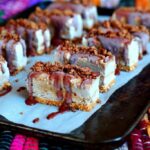Indulge in the sweet and salty goodness of Sea Salt Caramel Sauce. Perfect for topping your favorite desserts or enjoying straight from the jar!
Caramel lovers, rejoice! There’s nothing quite like the rich, buttery, and melt-in-your-mouth goodness of homemade caramel sauce. And when you add a touch of sea salt, it takes this classic treat to a whole new level. Our Sea Salt Caramel Sauce is perfect for dipping fruit in, making apple nachos, or enjoying with a spoon! It’s the perfect balance of sweet and salty and is sure to satisfy your cravings.
Using Real Ingredients
When it comes to making homemade caramel sauce, using real ingredients is a must. Real butter and real sugar are necessary to achieve the right texture, flavor, and consistency.
Do I have to use corn syrup?
Corn syrup is an invert sugar. Invert sugars inhibit the formation of crystals giving you smooth and creamy caramels every time. If you don’t have corn syrup or don’t want to use corn syrup, you can always make your own homemade invert sugar using sugar, water, and an acid (usually cream of tartar or citric acid). If you need to replace the corn syrup in this recipe, you’ll want to use another invert sugar that will also prevent crystalization, including:
Caramel Cooking Stages
Making caramel sauce requires an understanding of the different caramel cooking stages. Caramelization is a complex process that happens when sugar is heated, and it goes through various stages depending on the temperature it reaches. The first stage is the thread stage, where the sugar syrup forms thin threads when dropped from a spoon. This stage is often used in candy making or to sweeten hot drinks.
The next stage is the soft ball stage, where the sugar syrup forms a soft ball when dropped into cold water. This stage is perfect for making fudges, caramels, and caramel sauces. Soft ball stage occurs at 235-245°F and is achieved by cooking the sugar syrup until it reaches the temperature range.
The caramelization process can continue until the sugar reaches the burnt stage. In the case of our sea salt caramel sauce, we cook it to 200-205°F (93-96°C), which is just before it reaches the soft ball stage.
Graininess can occur if the sugar wasn’t fully dissolved before reaching the caramel stage. Make sure to stir constantly and scrape the bottom of the pan to prevent this from happening.
Yes, you can use unsalted butter, but keep in mind that it may make the sauce less salty than intended. Adjust the amount of salt accordingly.
The temperature of the caramel can affect its consistency. Make sure to use a candy thermometer to monitor the temperature and don’t cook it past the desired stage.
Brown sugar gives the caramel sauce a rich flavor and color, but you can use white sugar or a combination of both. Keep in mind that using white sugar may result in a different taste and color.
Serving Suggestions
This caramel sauce is incredibly versatile and can be served in many ways. Try it on top of ice cream, brownies, or pancakes. Or, use it as a dip for fruit or pretzels. It’s also delicious when drizzled over popcorn!

Storage Instructions
Store your caramel in a sealed container. It is shelf stable for up to one month.









